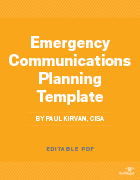Developing an emergency communications plan: A template for business continuity professionals
Communicating details in a crisis is a vital part of BC and resilience planning. Follow the steps below and the associated template to prepare an emergency communication plan.
Business continuity and resilience processes contain several important steps. Communicating information during and following a disaster to relevant parties is a key emergency management priority. This guide examines the steps an organization's emergency coordinator and business continuity (BC) and resilience teams must follow to create an effective emergency communications plan. It also provides a downloadable template to help prepare an executable crisis communications plan for a variety of incidents.
An emergency communications plan is often part of an overall emergency plan, which is typically aligned with BC and resilience plans. It should be detailed and designed to include information on how both internal and external crisis communications will be handled.
Experience from the COVID-19 pandemic demonstrated the importance of communications, especially as many employees turned to remote working. The continued growth of social media also figures prominently in emergency communications today, as it adds multiple pathways to communicate quickly with many people.
Internal emergency management alerts can be sent using email, building paging systems, voice messages or text messages to mobile devices, and social media and emergency notification systems (ENSes) that can be implemented on a local technology platform or via a cloud-based ENS vendor. This type of communication would include instructions to evacuate the building and relocate at assembly points, updates on the situation and notification of when it's safe to return. Such alerts might also be used for situations in which physical or technology security have been compromised, such as unauthorized building entry or a ransomware attack, respectively.
This article is part of
Complete crisis management guide and free template
External emergency communications that should be part of a business continuity and resilience plan include how to notify family members of an injury or death, discuss the disaster with the media and provide status information to key clients and stakeholders. The emergency coordinator must ensure that each message is prepared with the audience -- employees, media, families, government regulators -- in mind. Broad general announcements might be acceptable in the initial aftermath of an incident, but they must be tailored to the specific audiences in subsequent releases.
10 things your emergency communications plan must do
Emergency situations and disasters can range from fires, floods and severe weather to kidnappings, bomb threats and vandalism. An emergency communications plan must be able to do the following 10 things:
- Launch quickly.
- Brief senior management on the situation.
- Identify and brief the company spokesperson on the situation.
- Prepare and issue company statements to traditional media, social media and other relevant entities.
- Organize and facilitate broadcast media and social media coverage.
- Prepare technologies, such as email, wireless phones, smartphones, ENSes, social media platforms and satellite phones, for message distribution.
- Communicate situation information and procedural instructions to employees and other stakeholders via the methods above.
- Communicate with employees' families and the local community via the methods above.
- Continually adapt technologies, message content and timeframes for message delivery due to changing events associated with the emergency.
- Prepare in advance when using social media outlets to ensure messages are appropriate for the situation and that only authorized employees can issue messages via social media.
General emergency communications planning considerations
Here are seven important areas to be aware of when creating an emergency communications plan:
- Senior management support is essential. Without it, you won't be able to formulate a plan and could end up with a confused or unclear and ineffective response to an emergency. That could result in unfavorable traditional and social media coverage, negative public relations and, possibly, lawsuits.
- Keep it simple. A well-organized, step-by-step plan with relevant information at your fingertips will help you get through most incidents.
- Focus emergency content on relevant information. Provide only the relevant facts as they're available, get them out quickly and proactively, follow up regularly, keep interested parties informed, resolve incorrect information and tell the truth about the situation. This is especially true when using social media, as a poorly worded message could create serious problems for the organization.
- Review and test. Once the plan is complete, review it and try it out to ensure the documented procedures make sense and function correctly and that supporting materials -- press release forms, media briefing arrangements, electronic message delivery options, social messaging procedures and lists of critical contacts -- are up to date.
- Be flexible. A basic step-by-step plan and supporting document files should be enough to manage most emergency communications situations.
- Coordinate with corporate public relations. If your organization has its own internal marketing and/or PR department, work closely with the staff when developing an emergency communications plan by defining and assigning responsibilities, as that department might coordinate all external and internal crisis communications, especially with social media.
- Review insurance plans for dealing with emergencies. Considering the many different types of emergencies, check to see if existing insurance policies cover the disruptive event, especially if policies are in force that address losses from ransomware attacks and other cybersecurity events.
What you need before the emergency occurs
Every emergency is different. However, a standard set of resources and tools should be developed that will be useful to have in many situations. These resources and tools must be updated as needed and kept in a central location accessible to all members of the emergency response team.
The following information needs to be prepared and compiled before an emergency occurs:
- step-by-step emergency communications plan/playbook;
- list of internal contacts, e.g., employees;
- list of external contacts, e.g., traditional media, social media, vendors and government agencies;
- special forms, such as call logs to track inquiries from the media and others, an emergency contact directory, an incident description report, a social media report and a bomb threat report;
- prewritten documents, such as press releases, initial announcements and follow-up statements;
- location where traditional media will convene with provided power, network access, television monitors, briefing area and work area;
- establish policies to deal with social media in an emergency, e.g., who can issue messages and which social message platforms can be used;
- trained emergency communications team, especially those with knowledge of electronic messaging systems and social media;
- trained company spokesperson with at least one alternate;
- technology to rapidly disseminate emergency information to employees, stakeholders, suppliers, clients, government agencies and other external entities; and
- company policy on all aspects of emergency communications.
What you need during the emergency
As emergency operations progress, it's important to have certain pieces of information available, such as status reports, employee safety reports and communications with first responders. The crisis communications plan should include steps to collect and access this information and disseminate it to emergency responders and others who need it to carry out their responsibilities.
Regular updates to traditional and social media outlets must be considered, as the messages must be effectively prepared, delivered and managed to prevent any misunderstandings and potential reputational damage.
The plan might include setting up a central command center for emergency personnel. However, under some circumstances, they might not be able to access the central command center. The plan needs to work under both circumstances. Access to relevant technology in an emergency is essential, as is remote access to communications services. Be prepared to deliver the following information during the emergency:
- confirmed location of all employees;
- updated status reports on the incident;
- list of internal people contacted;
- list of external organizations contacted;
- list of resources needed, obtained and returned;
- actions taken during the incident;
- usage and performance of electronic notification and messaging systems, especially social media;
- updates to the emergency communications plan based on event experience;
- problems encountered and how they were resolved;
- persistent problems that require additional help; and
- narrative of the incident: what happened, what was done, the results and the outcomes.
What you need after the emergency
Once the emergency has ended, specific information will be needed to account for all employees and other people involved in the incident. Be sure to document all actions taken in an after-action report (AAR) and otherwise close out the incident.
The following post-event steps should be included in an emergency communications plan:
- confirm all employees have returned to work safely;
- complete final status reports on the incident delivered with an AAR;
- complete list of internal people contacted;
- complete list of external organizations contacted;
- complete list of resources needed, obtained, used and returned;
- report on the performance of emergency notification systems and social media;
- actions taken to end the incident;
- complete list of problems encountered and how they were resolved;
- complete narrative of the incident: what happened, what was done, the results and the outcomes; and
- update the emergency communications plan based on lessons learned from the event.
Examples of emergency communications situations
The examples below show how important emergency communications plans, supported by appropriate technology, spread critical information to large groups of businesses and citizens during emergency situations.
Washington, D.C., has dealt with severe winter storms over the past several decades. The U.S. Office of Personnel Management uses email, voice and text communications, as well as emergency notification technology to communicate the status of the Federal government to all employees in the National Capital Region. This process has been used on several occasions to notify government agencies that offices have been closed due to severe winter storms.
State and local governments located in areas prone to severe weather, especially tornadoes, must communicate with businesses and local citizens regarding potential storm situations. This is typically done using television, radio, social media, audible sirens, law enforcement patrols through residential areas making announcements and ENSes. Similar techniques are used to alert businesses and residents of conditions conducive to wildfires.
Emergency communications plan template
Getting messages out during and following an emergency presents many challenges. First, it's desirable to prepare an emergency communications plan that describes how the organization will respond to an incident and which mechanisms will be used to disseminate messages. It must have management support, be regularly reviewed and updated as needed, tested periodically and flexible enough to address a variety of emergency situations.
TechTarget has created a free, downloadable emergency communications plan template for business continuity and resilience professionals. It can be used as the foundation for a crisis communications plan. Each of the steps listed in the template has additional actions that must be defined and incorporated into the overall emergency management plan. Use the template to create an actionable emergency communications plan that can be launched following the onset of an incident.

 Click on the above image
Click on the above image 






